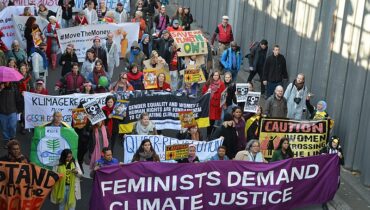The Philippines is one of the world’s most vulnerable populations to the effects of climate change. When the United Nations Office for Disaster Risk Reduction (UNISDR) evaluated disaster-prone countries in 2015, the Philippines ranked third. This is due, in part, to its geographic location as an archipelago with an exposed coastline, and its position in the Pacific Ring of Fire. Extreme weather events like flooding, typhoons, and earthquakes are common; on average, eight or nine tropical stormsmake landfall each year. The frequent occurrence of natural disasters poses particular challenges for a developing nation such as the Philippines, which lacks the financial resources and organizational capacity for comprehensive disaster risk reduction. Women have immense potential to bring about positive change in this context by contributing on-the-ground knowledge and building leadership within their communities. For the indigenous populations of the Philippines, engaging women is crucial to building resilient practices to adapt to the impacts of climate change and natural disasters.
Climate change will affect average and extreme temperatures, causing the likelihood of weather-related natural disasters to increase. Human activity significantly affecting the environment – such as deforestation, carbon emissions, and crop fertilization – is also known to be increasing the intensity and frequency of climate-related disasters, posing a challenge for governments, relief organizations, and local residents alike. In the Philippines, recent natural disasters such as Typhoons Pepeng and Haiyan, in 2009 and 2013 respectively, caused devastating economic and environmental damage. Loss of life and weather-induced displacement were exacerbated by poor infrastructure, which slowed delivery of aid in the aftermath, along with confusion among local and national authorities over their respective duties. While the National Disaster Risk Reduction Management Law and its Implementing Ruleswere passed in 2010 to ensure responsibility along each level of government, the systems in practice are not built out enough to effectively coordinate among sectors to address emergencies of such great magnitude and complexity.
In the wake of the frequent occurrence of natural disasters, agriculture is especially affected; in the Philippines, an average of 22% of the total economic impact of natural hazards is absorbed by this sector. Damaged cropland, reduced livestock populations, and altered transportation routes slow the recovery of the local economy and food supply. Thus, food security and climate change impacts are closely linked, and should serve as the basis for strategies of resilience and development. As the Philippines works to build capacity in adaptation, the perspective and knowledge of Indigenous Peoples (IPs), whose lifestyle is agriculture-dependent, cannot be discounted. The population of IPs is mainly concentrated in the Cordillera region, covering six provinces in the mountainous highlands of Northern Luzon, the Philippines’ main island. A diverse group of six tribes and eight languages, the group collectively known as the Igorot has maintained a strong sense of identity and pride throughout the region’s tumultuous history of colonization and occupation.
For subsistence farmers whose way of life revolves around rice cultivation, in addition to coffee and vegetable crops, the impact of climate change and natural disasters is felt to a greater extent among the Igorot. The communities have developed their own diverse and relevant ways of perceiving, preparing for, responding to, and recovering from natural disasters. As increasingly erratic weather patterns disrupt the growing cycle of irrigated rice, the total productivity of the Philippines is lowered, but IPs are particularly vulnerable to fluctuations in yield because they have conventionally been dependent solely on what they produce. Climate change heightens the need for Igorot men to supplement their income with outside work; a significant percentage seek employment outside their communities in extractive industries, such as gold and mineral mining, despite the environmental and political threat it poses to their land, or as overseas contract workers, a trend across the Philippines. Remittances are a crucial driver in consumer spending of Filipinos, accounting for 10% of total GDP in 2014.
Women play an integral role in this localized disaster risk reduction and management, stemming from their traditional position as community leaders, as well as the mobility of the male labor force in the region. Within the remaining population, women are the key drivers in all aspects of community organizing and developing resilience. In the village of Kapangan, mothers and female elders facilitate participatory governance by holding weekly meetings to make decisions related to water usage, crop yields, and sharing of farming equipment and labor. In Kapangan and among the Igorot, a communal attitude is standard practice, so a family that lacks an ox to furrow their rice fields for cultivation may exchange labor for the use of their neighbor’s ox. When yields are low, or a weather event damages one family’s crops, women’s group meetings are used to reallocate food and resources to ensure survival. In the event of a natural disaster or emergency, men clear pathways and search for any missing persons, while women ensure that property and food is secure and children are safe. In this way, women mobilize and carry out a culture of solidarity to sustain Kapangan’s livelihood and agricultural self-reliance.
Women have also developed innovative solutions to challenges posed by climate change and natural disasters. Conservation farming – in which coffee and root crops are interspersed with rice in order to have the most efficient water conservation and land use possible – generates income from local sales and increases crop diversification, protecting against the risk of crop failure due to altered weather patterns. Hazard mitigation is more difficult to integrate in indigenous communities, but women are overwhelmingly the collaborative force with the programs of local government, such as the National Disaster Risk Reduction and Management Council, and international organizations such as the Red Cross.
Local culture produces a wealth of traditional knowledge that cannot be discounted or marginalized. Sustained through oral tradition, early warning systems enable the Igorot to detect natural disasters through an acute awareness of changes in the environment. An impending typhoon can be signaled by the abnormal behavior of animals, for example, which will primarily be noticed by the women, and observing the sun and moon can signal weather patterns that will affect crop harvests. Cultural attitudes and social practices can play an empowering role in building resilient communities. The spiritual beliefs of the Igorot community account for the ambiguity of natural hazards, further social ties, and promote harmony with the natural environment. This spirituality can be seen during rehabilitation efforts, in which building and blessing new structures is a group effort, coordinated by the women, or in prayers led by female elders that acknowledge the land’s role in producing the food for the meal to follow.
Climate justice is essential to peace and security for the IPs in the Cordillera region and for the Philippines as a nation, and in this context there is much to be learned from the collaboration and organizing power of women. Inequities perpetuated by the global economic system – in which the Global North engages in production and resource extraction that generates wealth while the Global South bears the environmental cost – disproportionately affect women, and Indigenous women in particular. Resulting issues of health, food scarcity, and water access then fall upon women to respond to as caregivers. Bayanihan, a Tagalog word roughly translated to mean community unity and solidarity, is an important coping mechanism for indigenous peoples in the Philippines, but it is ultimately a supplement to, rather than a replacement for, local and national planning for disaster preparedness and mitigation. At all levels, women have a crucial role to play in ensuring environmental and economic sustainability for the future of the Philippines.
About the Author
Laura Fairman is an undergraduate research assistant with the Georgetown Institute for Women, Peace and Security. She is a sophomore in the School of Foreign Service studying International Politics with a certificate in Justice and Peace Studies. Laura is interested in social entrepreneurship and the economic empowerment of women.


